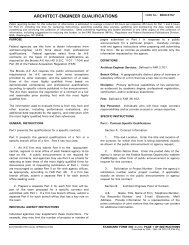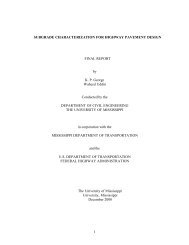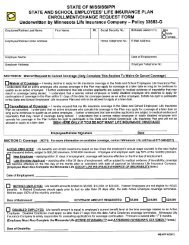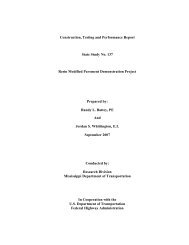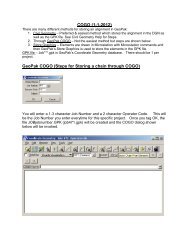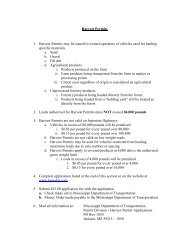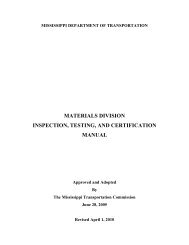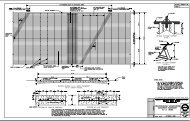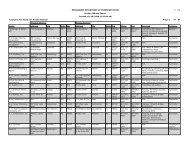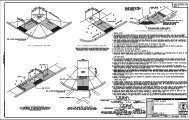State Study 111 - Polymer Modified Hot Mix Asphalt Field Trial.pdf
State Study 111 - Polymer Modified Hot Mix Asphalt Field Trial.pdf
State Study 111 - Polymer Modified Hot Mix Asphalt Field Trial.pdf
- No tags were found...
You also want an ePaper? Increase the reach of your titles
YUMPU automatically turns print PDFs into web optimized ePapers that Google loves.
CONTROL Section<br />
Both the binder and surface test values were acceptable. Stability was low for both mixes.<br />
ROTATIONAL VISCOMETER TESTS<br />
The rotational viscometer was used as part of SHRP Binder Tests to determine viscosity<br />
of the different modifiers. Figure 16 displays the viscosity with respect to temperature for<br />
the binder courses. At the lower temperature of 275 O F the modifiers are all spread out<br />
ranging from a high viscosity value of 2600 cP for MULTIGRADE to a lower value of 500<br />
cP for the CONTROL Section. All of the modifiers have higher viscosity at the lower<br />
temperature than the AC30 in the CONTROL. However, at the higher temperature of 374 O<br />
F, all of the modifiers are bunched together ranging from a high value of 400 cP for the<br />
NOVOPHALT modifier to a lower value less than 100 cP for the CONTROL and<br />
MULTIGRADE. The modifiers are all more viscous at the lower temperatures whereas the<br />
AC30 without a modifier did not change much in value.<br />
A similar chart is shown in figure 17 for the surface course with the results being the same<br />
as for the binder course, i.e., scatter of the data at the lower temperature and a bunching<br />
of the data at the higher temperature. MULTIGRADE, which is a gel, had a very high<br />
viscosity at the lower temperature but has the lowest at the higher temperature. The<br />
unmodified AC30 did not change much with increase in temperature.<br />
GYRATORY COMPACTOR TESTS<br />
The SGC was also used as part of the SHRP binder tests to determine densities on 6 in<br />
diameter pills at 7 percent air voids. Twenty-four samples were made for each modifier for<br />
the right lane pavement and these samples were to be tested later in the <strong>Asphalt</strong><br />
Pavement Analyzer to determine rutting resistance of each modified HMA.<br />
GYRATORY TEST MACHINE TESTS<br />
The US Army Corps of Engineers GTM was used to determine shear strength and air<br />
voids with respect to revolutions. Shear strength was calculated using the force diagram<br />
and equation from reference 1. The force diagram for computing shear strength has been<br />
reproduced and is shown in figure 18. Referring to the force diagram and taking moments<br />
about O (while neglecting wall friction and moment N x b), the formula for Gyratory shear<br />
(S G ) determined as follows:<br />
where:<br />
S G = 2 WL / Ah<br />
W = p x a = Load on roller<br />
L = Length of roller lever arm<br />
25




